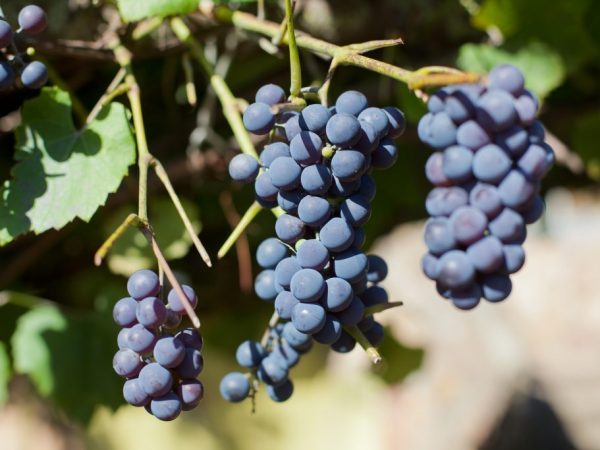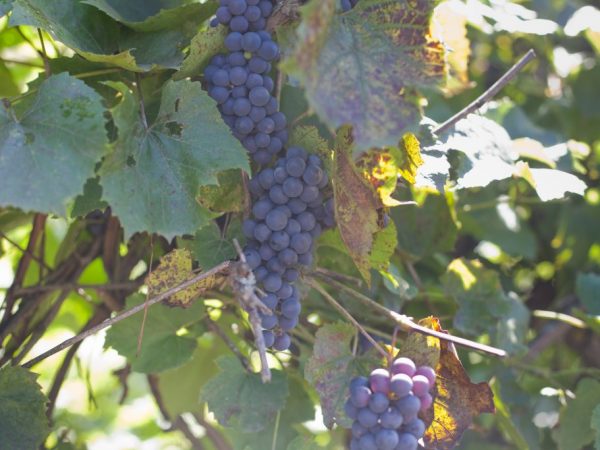Why do grapes fall
Grapes are perennial shrubs that are cultivated for berries. The fruits are used for processing into juices, alcoholic beverages, compotes and preserves, and also consumed raw. Grapes fall due to diseases and pests, as well as with improper care.

Reasons for falling grapes
Reasons for falling
The main reasons for shedding grapes:
- Lack of nutrients in the soil. If the soil is dry or little fertilizer is applied to it, then the plant does not develop well.
- Lack of moisture. For normal growth, the grapes are watered regularly.
- Weather. Cold snap causes loss of fruit and foliage.
- Dry air. Leaves crumble, and stigmas dry out, which interferes with the formation of pollen.
Scattering of grape ovaries also occurs from insufficient pollination. Poor growing conditions or disease can be the reason for this.
Diseases and pests
The reason for the shedding of ovaries and grape berries are the following diseases:
- milde;
- oidium;
- gray rot;
- powdery mildew;
- anthracnose;
- black spot.
Such diseases cause the appearance of stains, rotten formations and fungus on the grapes. The color of the leaves turns yellow, they dry up and fall off. The effect of diseases also spreads to bunches and fruits, where plaque appears, which makes the fruits unfit for consumption.
Pests of grapes:
- grape aphid;
- listoverta;
- cicada;
- pillowcase;
- goldfish;
- mite;
Such pests feed on grape juice, which causes a lack of nutrients for the leaves and bunches of berries. Also, insect larvae make passages in the branches, which causes the appearance of rot.
Lack of fertilizer

Lack of trace elements can lead to the fall of berries
For the normal growth of grapes, it is required to make the following substances:
- nitrogen complexes;
- phosphorus;
- potash fertilizers;
- bird droppings;
- manure;
- compost;
- wood ash.
The lack of these substances during the flowering period leads to the fact that the young ovary crumbles. Fertilizers are applied before flowering, during the appearance of the first ripe fruits and after removing the winter shelter.
Determining the cause
You can find out why the ovary crumbles in grapes based on the seasons. If the fruits fall in mid-July or early August, then the reason is the overabundance of fruits on the bunches and branches. An overloaded bush does not have enough nutrients to supply all the berries. For some varieties, fruit loss is normal.
During the flowering period, it is required to regularly inspect the bushes for the presence of pests and fungal diseases. This helps prevent their spread without the use of chemicals.
Protection methods
To prevent fetal loss, such operations are performed.
- maintain moisture in the soil;
- remove excess green shoots;
- pluck or remove the tops of the bush;
- carry out artificial pollination.
If the cause of shedding is dampness, then the bushes are treated with a special solution of ferrous sulfate and bromic acid diluted in water. Also, urea and citric acid are added to the mixture for the prevention of diseases. During the flowering period, it is better not to spray the bushes.
Spring and summer processing
To prevent the fall of the ovaries of grapes during the period of flowering and the appearance of fruits, spring digging is carried out. Loosening the soil improves the flow of air, moisture and beneficial minerals. Also, when digging, wood ash is added to the soil.
To prevent the appearance of diseases, the bush is sprayed with an infusion of ash. The ideal time for such a procedure is early and mid-August. The crop should be sprayed only after harvest, as moisture causes stains on the berries. Process every 8-10 days before the natural fall of the foliage. It is also required to harvest in a timely manner, since the long stays of ripe berries on bunches leads to their shedding.
Preventive measures
To prevent the possibility of ovary falling off, pinching the top above 17 leaves is carried out. They also cut off the stepsons and remove 4-5 leaves from the bottom of the plant, since they do not participate in photosynthesis, but require nutrients and close the berries from sunlight.
For the prevention of diseases, grapes are treated with the following means:
- Topaz;
- Horus;
- Thanos;
- Acrobat;
- Ridomil;
- Bordeaux mixture;
- Anthracol;
- Strobe.
Excess moisture should be monitored. Waterlogging causes the formation of rot and fungal diseases, which cause the ovaries and fruits to fall off.
Conclusion
In order for the grape bushes to grow well, you need to plant them correctly. The depth of the pits should be 40-60 cm, and the distance between them should be at least 2 m.
If a fungus is found on the branches, all affected segments are removed and treated with a growth stimulant. For watering the bushes, only clean, settled water is used.


